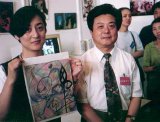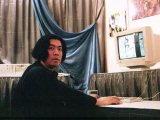Asia: A Refreshing Breeze.
Beijing Renga: Diary/part 1
NAKAMURA Rieko


Mr.GAO and me (left), Mr. Anzai (right)
Two "Souls" from China
For some unknown reason, I am forever picking things up; one of a pair of expensive earrings, a slightly warped ring . . . the list goes on. This time, I picked up an exceptionally fine experience of Asia.
Asia is fascinating. I had vaguely thought so for several years. The invitation from InterArt Association to exhibit in Beijing came in March. My Renga partner, Anzai and I immediately OK'ed the offer. (You see, I again picked up something I wanted.)
Long convinced that merely hanging work in an exhibition is uninteresting, we decided to arrange a new Renga session for this exhibition: Renga in Beijing 1996.
Since we would be going all the way to Beijing, we fathomed a session with a Chinese calligrapher. InterArt Association's Ms. TARUMI Kei coordinated the brainstorm for us, and thanks to her assiduous efforts, the collaboration with eminent calligrapher GAO Xia residing in Xi'an, was realized.
 Ms. Tarumi (above), Mr. Anzai (right), me (left)
Ms. Tarumi (above), Mr. Anzai (right), me (left)
Renga is collaboration we have cultivated exploiting the peculiarities of digital data and the digital network. Inviting a purely analog master into a purely digital mechanism was in plan alone, exciting to us and to our staff.
In early May, we received what became the seeds of Beijing Renga, two calligraphic works. Gao Xia selected the character "soul," rendering it once in tensho (seal script) and once in kokotsu moji (oracle bone inscription). The two pieces were scanned, Anzai and Nakamura each manipulated the digitized imagery, deforming, adding "brushwork" of their own, etc., etc., and the Beijing Renga's second generation was born.
To date, we have communicated via Renga with many people we are unable to communicate with in words. Chinese characters are strange, though, they are pictures, and they have meaning. They communicate something that is not communicated by pictures or words alone. We were thrilled over our dialogue with Mr. Gao whom we were yet to meet.
Nevertheless, for both Mr. Gao and for us, the process through the second generation differed none from our respective normal working processes. Gao Xia made calligraphic works and we manipulated digitized imagery as we always do. The problem would be the next generation. How would our digital work be received by Mr. Gao? Apparently the turning point of Beijing Renga lied here.
No "Souls" Return
Treading on unknown ground, both in content and methodology, we experimented also in technology. We used jetgraphy to print out on DIN B0-sized rice paper, (only one person in the printing industry knew of color this vivid from traditional printers.) Anzai took the care to disassemble his work into numerous parts from which Gao could choose freely. We included a letter politely explaining our intent that Mr. Gao do anything he pleased on this paper, to be interpreted by Ms. JO Shin, a talented member of the InterArt staff originally from Shanghai who had completed her graduate studies in linguistics and comparative cultures at Yokohama National University.We put the prints in a tube and FedEx'ed them to Xi'an on May 8th. They would arrive in about a week, what would Mr. Gao Xia cook up with them? We waited, day after day, to be informed . . . . But nothing.
My partner was jolted awake in a cold sweat having dreamt that the Chinese master calligrapher felt a repugnance for this kind of collaboration. In the meantime, it was approaching the one week mark before we were to make our appearance at the exhibition in Beijing. On May 20th, we received a telephone call from Ms. Tarumi from Beijing, "the FedEx package arrived in Xi'an today. Prof. Gao Xia will begin work."
China is a faraway land.
What? Touch Somebody's Work?
May 27
I cannot say we were all set, but on the runway we were, and we arrived in Beijing. A four-hour flight and one-hour time difference from Japan.
We were not able to exchange a word with the local staff sent to the airport to greet us. Secretly harboring the fear that we might be abducted along the way, we arrived at Vision Quest 1996 at Beijing International Convention Center without a hitch.
May 28
We met Mr. Gao Xia who arrived in Beijing from Xi'an. We also had our first encounter with Mr. Gao's third generation work.
Contrary to our expectations, Gao did not add his brushwork directly to our second generation works. Instead, picking up on configurations present in our work, he made completely new pieces using a combination of ink and watercolor techniques. The two pieces bore his signature and his seal. They were inspired by our CG work, but undoubtedly Gao Xia's own calligraphy.
Gao explained, "I looked at the pieces you sent from Japan, and admired them together with my colleagues/friends. We discussed the matter. 'These are works of art!?' You said do whatever, but is it really alright to freely tear them and make collages or add brushwork to them? I think your work is superb. Therefore I am just unable to do this."
Now I see! This was a natural response for someone like Gao Xia producing work in an analog world where but one original exists. We had become thoroughly accustomed to the CG environment where there is no such thing as damaging originals, and the ability to rework and reproduce infinitely.
Back at the exhibition hall booth, the installation of paint tools, production environment set up, and connection to Internet, miraculously finished like clockwork and there was nothing left to do but wait for tomorrow's live Renga.
